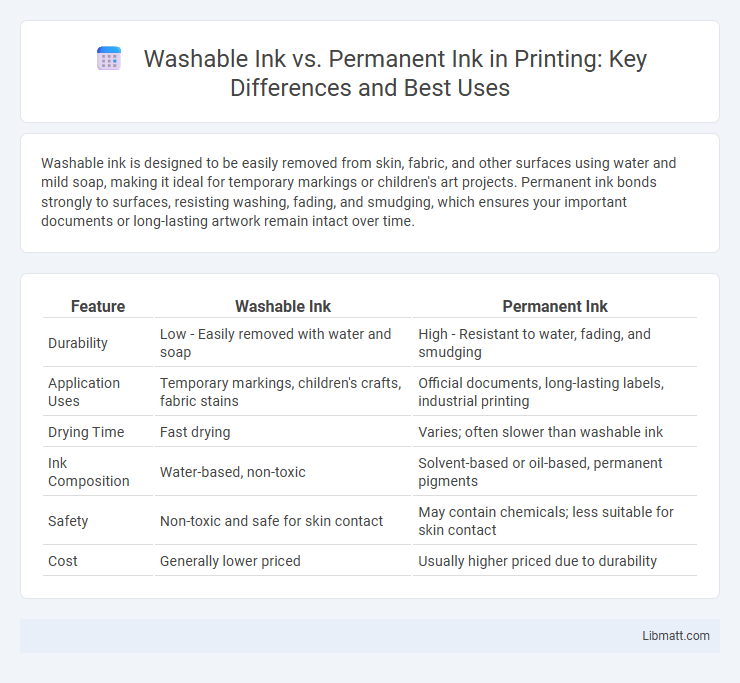Washable ink is designed to be easily removed from skin, fabric, and other surfaces using water and mild soap, making it ideal for temporary markings or children's art projects. Permanent ink bonds strongly to surfaces, resisting washing, fading, and smudging, which ensures your important documents or long-lasting artwork remain intact over time.
Table of Comparison
| Feature | Washable Ink | Permanent Ink |
|---|---|---|
| Durability | Low - Easily removed with water and soap | High - Resistant to water, fading, and smudging |
| Application Uses | Temporary markings, children's crafts, fabric stains | Official documents, long-lasting labels, industrial printing |
| Drying Time | Fast drying | Varies; often slower than washable ink |
| Ink Composition | Water-based, non-toxic | Solvent-based or oil-based, permanent pigments |
| Safety | Non-toxic and safe for skin contact | May contain chemicals; less suitable for skin contact |
| Cost | Generally lower priced | Usually higher priced due to durability |
Introduction to Washable and Permanent Inks
Washable ink is designed to easily come off fabric or skin with water, making it ideal for temporary markings and children's art projects. Permanent ink contains pigments or dyes that bond strongly with surfaces, providing long-lasting, smudge-proof results on paper, plastic, or metal. Understanding the differences between washable and permanent inks helps you choose the right type for your specific application, ensuring durability or easy removal as needed.
Key Differences Between Washable and Permanent Ink
Washable ink is designed to be easily removed from fabrics and skin using water or mild detergents, while permanent ink forms a durable, water-resistant bond that resists fading and washing. Washable ink typically contains water-soluble dyes, making it ideal for temporary markings, whereas permanent ink uses solvents or pigment-based formulas for long-lasting visibility. The difference in chemical composition leads to contrasting applications, with washable ink favored for children's crafts and temporary labels, and permanent ink suited for archival writing, industrial use, and outdoor labeling.
Composition and Formulation of Inks
Washable ink typically contains water-soluble dyes and less binding agents, allowing it to dissolve easily during laundering, making it ideal for temporary markings on fabrics and children's art supplies. Permanent ink is composed of pigment-based particles suspended in an oil or solvent medium, combined with strong binding agents that adhere firmly to surfaces, ensuring long-lasting durability and resistance to washing and fading. The chemical formulation differences directly impact ink absorption, drying time, and resistance properties, making washable ink suitable for temporary use and permanent ink for archival or industrial applications.
Application Areas: Where Each Ink Excels
Washable ink excels in temporary applications such as children's art projects, educational settings, and fabric designs that require frequent cleaning without residue. Permanent ink is ideal for professional documents, archival records, and industrial labeling where durability, water resistance, and fade-proof qualities are essential. The choice between washable and permanent ink depends primarily on the need for longevity versus easy removability in various use cases.
Ease of Removal: Washable vs Permanent Ink
Washable ink offers superior ease of removal, dissolving quickly with water and mild soap, making it ideal for temporary markings or children's crafts. Permanent ink bonds deeply with surfaces, resisting water and common cleaning agents, ensuring longevity but complicating removal efforts. Your choice depends on whether you prioritize easy cleanup or long-lasting durability.
Durability and Longevity on Various Surfaces
Washable ink offers limited durability, fading quickly on fabrics and porous surfaces after a few washes, making it ideal for temporary markings or children's artwork. Permanent ink provides superior longevity, resisting water, UV exposure, and abrasion on a wide range of surfaces including plastics, metals, and textiles. For applications requiring long-lasting visibility and resistance to environmental factors, permanent ink is the preferred choice.
Safety and Environmental Impact
Washable ink is generally safer for skin contact and children due to its non-toxic, water-based formulation that easily rinses off, reducing the risk of irritation or ingestion hazards. Permanent ink contains solvents and pigments that can release volatile organic compounds (VOCs), posing health risks during prolonged exposure and contributing to indoor air pollution. Environmentally, washable inks degrade more quickly in water systems, minimizing ecological impact, while permanent inks resist breakdown, potentially accumulating in soil and waterways and affecting wildlife.
Best Use Cases for Washable Ink
Washable ink is ideal for children's art projects, temporary marking on fabrics, and educational activities where easy removal is essential. It performs well on surfaces like paper, skin, and textiles, allowing quick cleanup without staining. This ink type is favored in classrooms, crafts, and environments requiring frequent changes or non-permanent results.
Ideal Scenarios for Permanent Ink
Permanent ink excels in scenarios requiring durability and resistance to water, fading, and smudging, making it ideal for official documents, archival records, and product labeling. Its strong adhesion properties ensure legibility over time on diverse surfaces such as plastic, metal, and glass. Industries like manufacturing, healthcare, and law enforcement rely on permanent ink to maintain the integrity of critical information.
Choosing the Right Ink for Your Needs
Choosing washable ink offers the advantage of easy removal from fabrics and skin, making it ideal for temporary projects such as children's crafts and non-permanent markings. Permanent ink provides long-lasting durability and resistance to water and fading, suitable for archival documents, professional labels, and outdoor applications. Evaluating the specific use case, including exposure to washing, durability requirements, and surface type, ensures the right ink choice for optimal performance.
washable ink vs permanent ink Infographic

 libmatt.com
libmatt.com